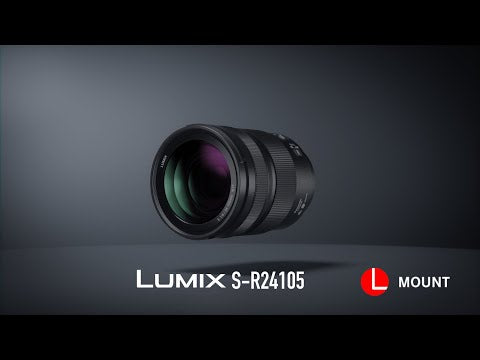Product Description
Panasonic Lumix S Series 24-105mm F4 Macro O.I.S. Lens - L mount
- Macro design provides half life-size 1:2 magnification ratio and a minimum focusing distance of 11.8" for working with close-up subjects.
- Optical Image Stabilizer minimizes the appearance of camera shake for sharper handheld shooting, and also supports 5-Axis Dual I.S. 2 for increased stabilization performance.
- AF/MF switch permits quick changing between focusing modes and a zoom lock switch can be used to prevent the lens from extending when not in use.
- Splash, dust, and freezeproof design benefits working in inclement weather conditions down to -14°F.
- Rounded nine-blade diaphragm contributes to a pleasing bokeh quality.
Covering a versatile wide-angle to short-telephoto range, the Lumix S 24-105mm f/4 Macro O.I.S. from Panasonic is a flexible zoom, featuring a constant f/4 maximum aperture, for L-mount mirrorless cameras. In regard to its optical design, a series of low dispersion and aspherical elements are used to control a variety of aberrations, colour fringing, and distortion in order to realize a high degree of sharpness, clarity, and colour accuracy.
Balancing its optical performance, this zoom is unique due to its 1:2 maximum magnification ratio and 11.8" minimum focusing distance to suit working with close-up subjects. Additionally, an Optical Image Stabilizer helps to control the effects of camera shake for sharper handheld shooting and the lens sports a weather-sealed design for use in harsh conditions.
Standard 24-105mm zoom is designed for full-frame L-mount mirrorless cameras, however, can also be used with APS-C models where it provides a 36-157.5mm equivalent focal length range.
Constant f/4 maximum aperture maintains consistent illumination throughout the zoom range.
Four aspherical elements, including two made from extra-low dispersion glass, help to minimize distortions and spherical aberrations throughout the zoom range in order to maintain edge-to-edge sharpness and illumination.
One ultra extra-low dispersion element and two extra-low dispersion elements greatly reduce chromatic aberrations and colour fringing in order to produce a high degree of clarity and colour accuracy.
For full specifications click Here


























